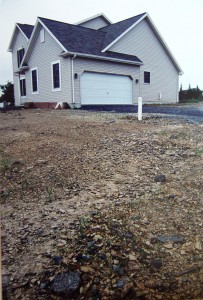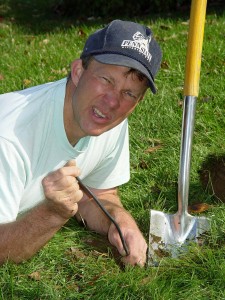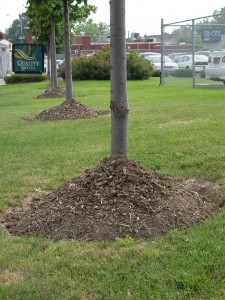20 Things I Wish Someone Would’ve Told Me
Experience is the best teacher. Unfortunately, that’s the very thing we lack most when starting out in gardening.
Over time, we gradually figure it out as we foul up and then correct one yard disaster after another. But by then, we’re too old and too tired to do much about it anymore.
So before I head off to the Old Gardener’s Home, here are 20 things I wish somebody would’ve told me 30 years ago…
1.) “Your soil is atrocious. Fix it.” The “soil” under most yards is usually 6 inches of marginal clay/shale spread out on top of heavily graded subsoil.
This is bad for drainage and root development. It sets your plants up for trouble no matter how much you fertilize or baby them.
The fix is to loosen what you’ve got to 10 or 12 inches (if you can) and work in 2 or 3 inches of compost or similar organic matter. You’ll end up with slightly raised beds of loose soil.
2.) “Before digging anywhere, know where your buried lines are.” Cable and Internet lines, in particular, often are only a few inches down.
I know. I severed a cable line on the very first hole I dug in my back yard. It wasn’t even along the property line. Most of my neighbors have hit lines in random places, too.
Don’t even try to guess. Call Pa. One-Call at 811 before digging anywhere. Utilities will mark your lines. It’s free for home gardeners.
3.) “You can’t plant whatever you like wherever you want.” Different plants have different needs. They’re live objects.
If you don’t give a plant the conditions it likes, it may croak. So it’s well worth assessing your condition, then doing homework to pick plants that suit that site.
This is what makes landscaping trickier than interior decorating. Also, interior designers don’t have to worry about groundhogs eating the coffee table.
4.) “Plants don’t stay the way you put them.”They grow… some much bigger and faster than others.
Know those mature sizes and plan accordingly. Remember, only dead plants stop growing.
5.) “Be patient. The fast-growing stuff usually isn’t best in the long run.” Fast-growing woody plants tend to be weak-wooded, which generally makes them more prone to breaking and/or flopping apart in storms as they age.
Yeah, I know you want those little plants — especially trees — to look like something soon. But there’s much to be said for compact, slow-growing plants.
6.) “Different parts of the yard can be drastically different.” Every yard has “microclimates” that can determine what plants will work where.
Some areas get morning sun and afternoon shade. Others are in full sun or constant shade. Some areas might be dry, some might be wet. Some spots are windy, some are frost pockets.
Get to know these vagaries, and you’ll save much on dead-plant costs. Also, it’s much better to match your plants to existing microclimates than to try and change conditions to suit the plant.
7.) “There IS a plant that will live in any part of your yard.” If lupines can grow in volcanic rock in Iceland and datura can seed itself into driveway cracks, there’s a plant that can survive even in your lousy yard.
The trick is figuring out what it is. Don’t give up so easily. And don’t keep replanting the same dying thing in the same spot and expecting a different outcome.
8.) “Don’t plant big trees anywhere near the house or power lines.” Young trees might look little and innocent enough when you plant them, but if you picked something that will mature above the power lines or tall enough to crash into your roof if it should fall, you’re heading for trouble.
Falling trees are the reason behind most power outages in storms.
Big trees are fine in big spaces. In small spaces, go with small trees or tall shrubs.
9.) “Deeper is not better.” Planting a tree extra deep doesn’t make it less likely to blow over. The opposite is true.
Too-deep planting is a leading cause of tree death. It rots the bark and suffocates the roots.
Plant just above grade so you can see the “root flare” above the ground. The root flare is where the trunk widens out as it transitions into the roots.
10.) “More is not better either.” Don’t jack up the fertilizer dose, figuring it’ll make the grass even greener.
Twice the dose of pesticide won’t kill your bugs or weeds twice as fast either.
Read the label and follow it exactly. Don’t risk burning the lawn or killing your plants along with the bugs.
11.) “Some plants are just way better and way less trouble than others.” All plants are not created equal. Some are naturally more prone to bugs, diseases and other mayhem than others.
There are lots of great, low-care, low-trouble choices. It just takes some homework to know what they are.
Two sources: my Patriot-News Plant Pick of the Week profiles (250 of them archived at www.georgeweigel.net/plant-of-the-week-profiles) and an 18-page “George’s Survivor Plants for Central Pennsylvania” manual that details the local cream of the crop based on my 30 years of trial and error ($5.95 download at www.georgeweigel.net/helpful-info-you-can-buy).
Also visit public gardens and quality garden centers to get familiar with good plants.
12.) “Just because you see pros packing mulch up onto the trunk of trees doesn’t mean it’s right.” This has the same effect as planting too deeply in the first place — it rots bark and suffocates roots.
Keep mulch a few inches away from the trunk. Three to four inches is plenty over the rest of the bed under the tree’s canopy.
13.) “Plants can die from not enough water.” Also, “Plants can die from too much water.” The goal is damp, never soggy.
Your finger is a good gauge. If the soil isn’t damp all around and just under the rootball, it’s time to add water.
Needed amounts vary by weather and soil type. The first 6 weeks after planting is most critical.
14.) “Lawns aren’t as low-care as you might think.” Add up all the bug and disease controls, the crabgrass preventers, fertilizers, weed-killers, water, etc. and a big lawn isn’t particularly cheap or low-care.
What other plant do we prune 25 times a season?
Consider converting at least some lawn to truly low-care plantings.
15.) “The truly lowest-care yard is a mix of:” a.) Trees with groundcover; b.) dwarf evergreens, and c.) compact flowering shrubs.
According to “George’s Garden-Work Pyramid,” the lowest- to highest-care plant families are: cutting roses and fruit trees; vegetable gardens; beds of annual flowers; perennial gardens; the lawn (unless you’re a lawn fanatic, in which case it’s No. 2 on the list); flowers in pots; compact evergreens and shrubs, and least of all, trees with groundcover underneath.
16.) “Just because perennials come back every year doesn’t mean they’re no work.” Yeah, you don’t have to replant them every spring, but perennials don’t bloom as long as annuals, and most of them require annual cutbacks, some in-season primping and occasional division, fertilizer and water.
17.) “You can’t prune whatever you want whenever you feel like it.” You may not kill your plants outright with ill-timed pruning, but there’s a good chance you’ll get few or no flowers the following season because you cut off the flower buds.
Rule of thumb: If it blooms early (i.e. before mid-June), prune it right after it’s done flowering. If it blooms later (i.e. after mid-June), prune it early (going into the season).
Fall is a bad time to prune anything.
18.) “Beware of friends bearing gift plants.” You may well get a great plant for free, but you also may get someone else’s thug.
People are most likely to give away plants that have been getting too frisky in their own yard.
Know what plant you’re being offered, ask how frisky it’s been, and just say no if you’re in doubt.
Sixteen common pass-alongs that cross my line: ribbongrass, houttuynia, morning glory, hardy ageratum, mint, bamboo, yellow archangel, bishop’s weed, creeping jenny, ivy, Johnny jump-ups, bugleweed (ajuga), bellflowers, bronze fennel, spiderwort and obedient plant.
19.) “If you’re thinking about growing vegetables, get a fence up first.” You can try repellents, traps and hoping for the best, but growing vegetables is like a free dinner invitation to every animal within 10 miles.
The Big Four are rabbits, voles, deer and my arch nemesis, the groundhog.
Some people use electric fences. I have an unsecured 3-foot-high fence with a buried board to prevent tunneling of rabbits and groundhogs (no deer problems).
Also good is a post-and-rail fence with vinyl fencing secured to the inside and a buried board under it all.
For deer, it’ll probably take an 8-foot-tall perimeter fence or two parallel 5-foot fences spaced 4 feet apart.
20.) “Don’t take it all too seriously. Have fun.” Life has enough trouble outside of the cabbage patch.
Gardening should be fun. Don’t sweat it if an azalea dies or a stink bug shows up.
You want a train in the back yard? Do you like the looks of one of those blue bottle trees? Does a polka-dotted frog statue make you smile?
Go for it. It’s your yard.













